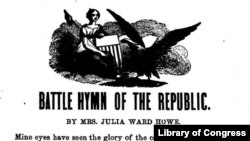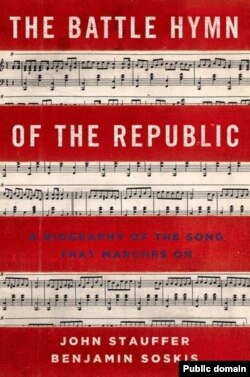Though the Battle Hymn of the Republic is more than 150 years old, it is still embraced by Americans of all political persuasions. According to Ben Soskis, co-author of a new book about the song, that’s because it speaks to a particularly American sensibility.
“The idea that America has the providential responsibility to help bring the world into a realm of perfect peace and to bring freedom to the world,” he said.
That’s not how the song started out. It had a meandering path to become the iconic anthem it is today.
“As far as we know, it can be traced back to an early Camp Meeting Revival hymnal in 1806,” Soskis said of the song “On Canaan’s Happy Shore.”
“It had the 'Glory, glory, Hallelujah’ chorus,” he said.
Fifty years later, during the Civil War, the Canaan song was popular with a group of Northern solders in Boston who had a man in their unit named John Brown - the same name as the famous abolitionist who had been hanged after trying to start a slave uprising in 1859. The men in the unit liked to tease Brown about having such a famous name.
“They would say ‘Oh, there goes John Brown.’ And somebody else would say, ‘I thought John Brown was dead.’ And another would say, ‘Oh, but he's still marching on,’” Soskis said.
Eventually, Soskis says, the men turned their teasing jokes into a song. The tune they picked was “Canaan's Happy Shore.’” Over time, the song, “John Brown’s Body” became "probably the most popular marching song of the Union cause,” he said.
In the early days of the American Civil War, poet Julia Ward Howe visited Washington, D.C. with some fellow dignitaries. Outside the city she got stuck on a road jammed with soldiers. To bide time, Soskis says, the Union troops were singing a rowdy version of, "John Brown's Body."
“Her minister was sitting beside her and turns to her and says, ‘Julia, you know you really should write some decent words to that song,’” he said.
She went back to her hotel, he said, and woke in the middle of the night …“With the words literally marching in her head,” Soskis said.
After the Civil War, there were many who pushed to make the Battle Hymn of the Republic the country's national anthem. That movement failed, largely because southerners hated the northern song’s tone of moral triumph.
“Its lyrics a call to crush the Confederates as one would a serpent under one's heel,” Soskis said.
Over the decades, though, the serpent verses were discretely dropped and the song was embraced even in the South. New lyrics would be written for new causes by activists who felt not only that "truth was marching on,” but that it was marching on their side.
America’s early labor movement adopted the tune. John Steinbeck’s anti-poverty novel, “The Grapes of Wrath” took its title from the song. The Battle Hymn was sung during the Civil Rights Movement. And the last words Martin Luther King, Jr. ever spoke in public were from Julia Ward Howe’s lyric.
“I’m not fearing any man! Mine eyes have seen the glory of the coming of the Lord,” King said in Memphis on April 3, 1968.
Soskis says the song endures because, for better or worse, it speaks to America’s sense of itself as a country with a mission.
“No song captures it better than the Battle Hymn,” he said.
“The idea that America has the providential responsibility to help bring the world into a realm of perfect peace and to bring freedom to the world,” he said.
That’s not how the song started out. It had a meandering path to become the iconic anthem it is today.
“As far as we know, it can be traced back to an early Camp Meeting Revival hymnal in 1806,” Soskis said of the song “On Canaan’s Happy Shore.”
“It had the 'Glory, glory, Hallelujah’ chorus,” he said.
Fifty years later, during the Civil War, the Canaan song was popular with a group of Northern solders in Boston who had a man in their unit named John Brown - the same name as the famous abolitionist who had been hanged after trying to start a slave uprising in 1859. The men in the unit liked to tease Brown about having such a famous name.
“They would say ‘Oh, there goes John Brown.’ And somebody else would say, ‘I thought John Brown was dead.’ And another would say, ‘Oh, but he's still marching on,’” Soskis said.
Eventually, Soskis says, the men turned their teasing jokes into a song. The tune they picked was “Canaan's Happy Shore.’” Over time, the song, “John Brown’s Body” became "probably the most popular marching song of the Union cause,” he said.
In the early days of the American Civil War, poet Julia Ward Howe visited Washington, D.C. with some fellow dignitaries. Outside the city she got stuck on a road jammed with soldiers. To bide time, Soskis says, the Union troops were singing a rowdy version of, "John Brown's Body."
“Her minister was sitting beside her and turns to her and says, ‘Julia, you know you really should write some decent words to that song,’” he said.
She went back to her hotel, he said, and woke in the middle of the night …“With the words literally marching in her head,” Soskis said.
After the Civil War, there were many who pushed to make the Battle Hymn of the Republic the country's national anthem. That movement failed, largely because southerners hated the northern song’s tone of moral triumph.
“Its lyrics a call to crush the Confederates as one would a serpent under one's heel,” Soskis said.
Over the decades, though, the serpent verses were discretely dropped and the song was embraced even in the South. New lyrics would be written for new causes by activists who felt not only that "truth was marching on,” but that it was marching on their side.
America’s early labor movement adopted the tune. John Steinbeck’s anti-poverty novel, “The Grapes of Wrath” took its title from the song. The Battle Hymn was sung during the Civil Rights Movement. And the last words Martin Luther King, Jr. ever spoke in public were from Julia Ward Howe’s lyric.
“I’m not fearing any man! Mine eyes have seen the glory of the coming of the Lord,” King said in Memphis on April 3, 1968.
Soskis says the song endures because, for better or worse, it speaks to America’s sense of itself as a country with a mission.
“No song captures it better than the Battle Hymn,” he said.











